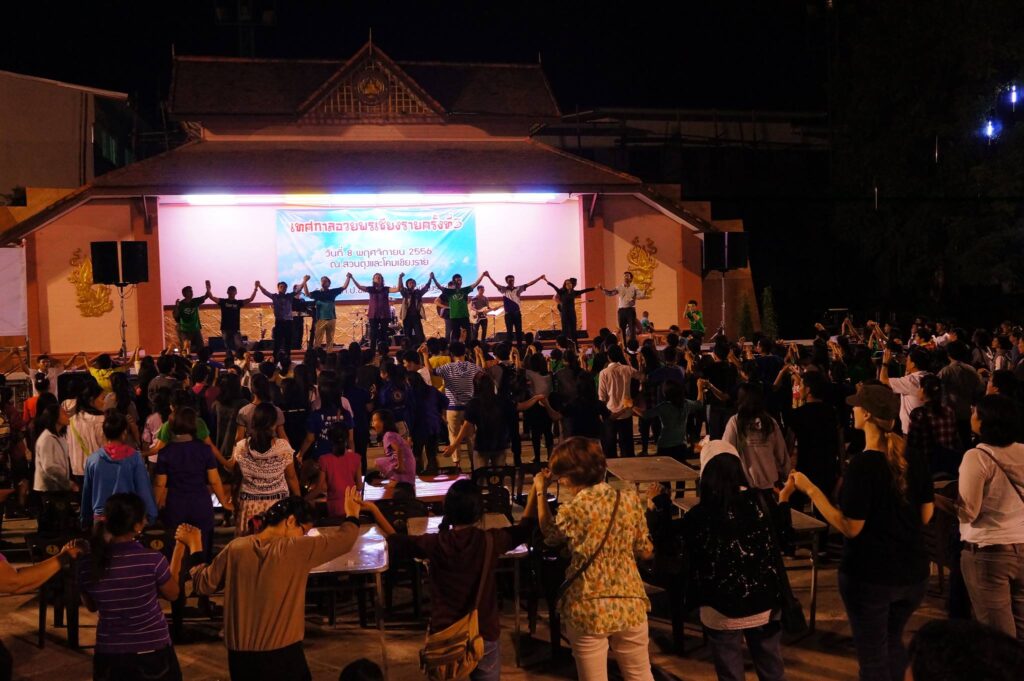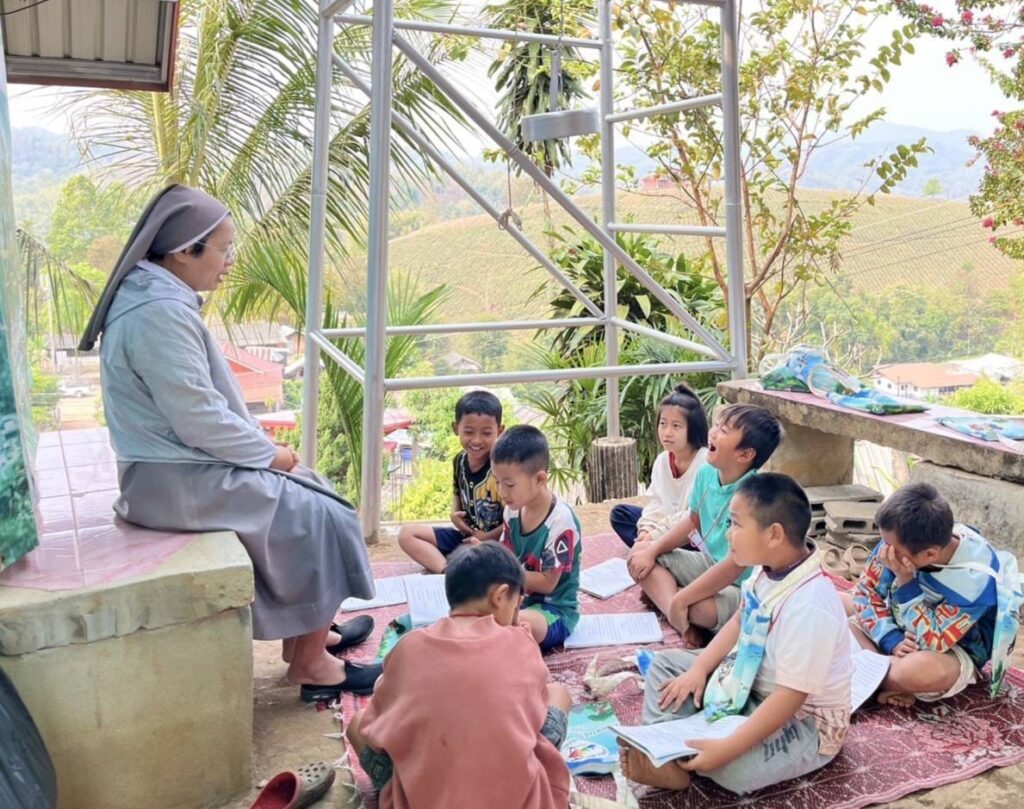CHIANG RAI – In Thailand, where Buddhism remains the heart of daily life for most people, Christianity is gaining ground quietly but steadily. With almost 1 million followers, Christians now make up about 1.4% of the population.
Although this is a small minority, the increase stands out in a country where 93.6% of people identify as Buddhist. The northern provinces of Chiang Mai, Chiang Rai and Mae Hong Son now house over half of all Thai Christians. In these regions, churches are being built, Christian schools are thriving, and mission work continues to reach new communities.

Faith Finds a Place in the North
Theravada Buddhism deeply shapes Thai society, with temples at the centre of every village. Yet, parts of northern Thailand have seen Christian communities take root. By 2021, some districts like Chomtong in Chiang Mai recorded Christians making up 16% of the local population, with even greater percentages in certain tribal areas such as Mae Sariang in Mae Hong Son.
Figures from 2011 show Christianity in Thailand grew at an annual rate of 5.22%, while the country’s overall population grew by just 0.57%. This momentum carries on, fuelled by the work of local churches, overseas missionaries and a readiness among some groups to accept new beliefs.
Choosing Christianity isn’t always simple in Thailand. Buddhism is closely linked to Thai identity, so conversion can bring family tension or resistance from the wider community. In the 19th century, early Christian converts in Chiang Mai faced extreme consequences — two were executed for their faith. While outright persecution is rare today, social pressures haven’t vanished. Christianity is growing most quickly among northern tribal peoples like the Karen, many of whom have adopted the faith.

Why Northern Provinces Lead
Northern Thailand, especially Chiang Mai, Chiang Rai and Mae Hong Son, has become a stronghold for Christianity. Over half of the country’s Christians live in these three provinces. Tribal communities, sometimes set apart from mainstream Thai society, have proven more open to Christianity than ethnic Thais, who often see Buddhism as central to being Thai.
Missionaries have served these communities for nearly two centuries, winning trust and offering support. The north’s history, shaped by the independence of the Lanna Kingdom, has played a part in making the region more receptive to outside ideas.
Chiang Mai stands out as a base for Christian activity. The city is home to over 4,000 missionaries, mainly from the US, South Korea and Australia, who support churches, schools and charities. Under Bishop Francis Xavier Vira Arpondratana, the diocese serves 60,000 Catholics, mostly from tribal backgrounds. The Church of Christ in Thailand and other groups run radio stations, shops and community projects, all with a local focus.
Chiang Rai shares much of this character, with nearly 20% of the country’s Christians living here. Mae Hong Son follows, with just over 8%. Many villages in these provinces, especially those home to hill tribes like the Karen, now feature churches alongside traditional bamboo homes. The Karen, skilled in silversmithing and working with elephants, began adopting Christianity after British missionaries arrived in the 19th century.

Chiang Rai’s Christian Community
Christianity shows a visible presence in both Chiang Rai’s towns and countryside. The Christian population brings together ethnic Thais, Karen, and other hill tribes. Some churches, like All Saints Chiang Mai, welcome the LGBT community, while most take a more traditional approach.
Russian Orthodox congregations, such as Holy Trinity on Phuket, also reach into Chiang Rai, serving both expats and locals. Services are offered in several languages, including Thai, English and Russian, reflecting the area’s growing international links.
Christians in Chiang Rai often meet in small, close-knit groups. They face the challenge of explaining their beliefs to their Buddhist neighbours, but mutual support helps them continue. As Somchai, a local convert, explains, “We show our faith through how we treat others.” Events like the 2009 My Hope campaign drew thousands, with more than 1,700 churches across Thailand taking part.
Radio stations in the north help spread Christian messages, with one station alone helping to establish eight new churches and even one across the border in Laos. These efforts combine media and personal outreach to reach people in areas where old traditions still hold strong.

Christian Schools Shape the Future
Christian schools have played a big part in Christianity’s spread in northern Thailand. Since the 1800s, missionaries have set up schools to share their beliefs while offering education. In Chiang Rai, Chiang Rai International Christian School (CRICS) opened in 1998 and now serves both missionary families and locals. The school teaches in English and focuses on compassion and service.
In Chiang Mai, schools such as Grace International School (GIS) and Chiang Mai International School (CMIS) blend academic study with Christian teaching. GIS follows an American curriculum and supports both missionary and local students, helping them grow in their faith as well as their studies.
CMIS is open to families of all backgrounds but promotes Christian values. These schools attract a wide mix of students and offer community support through sports and charity work.
Long-standing institutions like Prince Royal’s College and Payap University, both founded by missionaries in Chiang Mai, have influenced education across Thailand, especially for girls. Many graduates stay active in church life, keeping the connection between education and faith alive.
Missions at the Centre of Growth
Missionary work sits at the heart of Christianity’s progress in northern Thailand. American Baptists first arrived in 1833, followed by Presbyterians in 1840, and soon targeted the north. Missionaries like Daniel McGilvary, who started First Church in Chiang Mai in 1868, set the foundations for today’s Christian communities, especially among tribal groups.
Organizations such as OMF International and Serge now support local pastors in starting new churches. Serge Chiang Mai team helps Thai leaders share their beliefs in ways that fit local culture. Their projects include using online businesses to support church work, showing new approaches to traditional mission work.
The Christian Communications Institute at Payap University reaches out by using Thai music, dance and media to share Christian beliefs. Other groups, including World Vision and the Christian Development Fellowship, focus on helping people in need, tackling poverty and addiction alongside spiritual support. In Karen villages near Chiang Rai, missionaries bring education and healthcare as well as faith.

Ongoing Challenges and New Possibilities
Despite steady growth, Christianity in Thailand faces obstacles. Many church leaders find it hard to keep new believers involved, with only about 10% staying active. The idea that “to be Thai is to be Buddhist” still shapes attitudes. At the same time, there are new chances to connect with more people. The government has permitted Christian radio stations, and events like the 2007 pilgrimage at Assumption Cathedral bring Christians together.
In the north, the combination of tribal openness and continued work by missionaries offers hope for further growth. Allan Eubank, who has lived in Thailand for nearly sixty years, believes the region is ready for a wave of Christian renewal. As Christians from the north reach out to other parts of the country, there’s potential for the faith to expand further.
The rise of Christianity in Thailand, especially in Chiang Rai, Chiang Mai and Mae Hong Son, tells a story of resilience and new beginnings. Churches, schools and community projects show how faith can blend with Thai culture.
While challenges remain, the growing Christian presence in the north points to a future where new beliefs and old traditions can grow side by side. As a Chiang Rai pastor says, “We’re growing not just in number, but in care for each other.”







